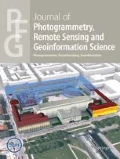Global forest ecosystems provide multiple merchantable and non-merchantable ecosystem services, and are highly required to be monitored and protected. One major ecosystem service is the minimization and mitigation of the negative effects of climate change. Depending on various spatial scales, different planning actions are required for forest management, which all entail one prerequisite in common: up-to-date quantitative information provided by regular forest monitoring and inventory. Descriptive and spatially explicit statistics on forest inventory variables over tree, sample plot and finally landscape levels are essential requirements for every sound planning and management strategy. With almost no exception, examples of such information can be summarized into three categories of composition (arrangement and presence/absence of species), function (processes and their dynamics) and structure (spatiotemporal distribution and allometric attributes of tree). Whereas the conventional field-based approaches based on permanent sample plots are constrained by their required time, costs and logistics, remote sensing data methods can complement and advance inventories for both science and practice, due to the potentials for accurate, repeatable and objective forest inventory and analysis. The history of remote sensing applications in forest inventories goes even beyond the early days of satellite earth observation and is as old as the era of aerial photogrammetric surveys.
This special issue of PFG presents a number of selected studies on the state-of-the-art research in inventory of forest stands by using multi-source remote sensing data and methods. We incorporated both experimental and practice-oriented research. Whereas studies like Gomroki et al. (2017) and Ghimire et al. (2017) rely on experimental approaches on small-scale test sites, Aryal et al. (2017), Zimmermann and Hoffmann (2017) and Gilani et al. (2017) represent workflows and results that are more related to forest inventory practice. In terms of data sources used, Gomroki et al. (2017), Aryal et al. (2017) and Ghimire et al. (2017) applied light detection and ranging (LiDAR), with the latter study applying very high geometric capabilities of terrestrial LiDAR surveys. In addition, the study by Zimmermann and Hoffmann (2017) represents geometric applications of stereo photogrammetry, which are considered as cost-effective alternatives to derive structural forest information in the absence of LiDAR data. Finally, a pure spectral exploitation of earth observation data has been followed by Gilani et al. (2017) who used very high-resolution GeoEye imagery for forest change and canopy cover assessments.
In the studies showcased here, we attempted to cover a broad geographical range across the existing major global biomes. Temperate ecosystems of Germany were present as study sites in works of Aryal et al. (2017) and Zimmermann and Hoffmann (2017). Gomroki et al. (2017) focused on temperate landscapes in the Caspian forest of Iran. The eastern Mediterranean ecosystem located in Greece was showcased by the study of Ghimire et al. (2017), and finally the area exemplified by Gilani et al. (2017) stretches from the sub-tropical to temperate ecosystems in Nepal.
Last but not least, the studies collected within the present special issue of PFG are by no means believed to cover all applications in remote sensing-assisted forest inventory and analysis, but the editors believe that the special issue succeeds in giving a short glimpse into the continuous advancements in forestry applications of remote sensing. The method development, research and practice in this realm continues almost parallel to the advancements in designing and launching modern remote sensing tools, and the way of transfer from experimental and methodical studies into cost-effective, practical surveys are paved day by day.
Guest editors
Dr. Hooman Latifi (Department of Remote Sensing, University of Würzburg)
Prof. Dr. Barbara Koch (Chair of Remote Sensing and Landscape Information Systems, University of Freiburg)
Author information
Authors and Affiliations
Corresponding author
Rights and permissions
About this article
Cite this article
Latifi, H., Koch, B. Editorial. PFG 85, 211–212 (2017). https://doi.org/10.1007/s41064-017-0036-x
Published:
Issue Date:
DOI: https://doi.org/10.1007/s41064-017-0036-x

